|
|
|
Information about Chestnuts
Dave Carlson - February 24, 2013
Cooking
There are many different methods for cooking chestnuts. Roasting chestnuts is the most frequently method used to prepare chestnuts, however, there are other options. Listed below are a few ways in which they are commonly cooked.
Like popcorn, fresh chestnuts have a closed shell with moisture trapped inside. When roasting, the moisture can forcefully pop the nut open. Always slit the shell to allow the steam pressure to escape. Otherwise the nut will burst with a small explosion.
Oven Roasted Chestnuts - Method 1 (Oven Roasted)
- Preheat the oven to 375 degrees Fahrenheit.
- With a sharp knife, make a slit through both the smooth outer shell and the textured inner skin. This will allow the steam pressure to escape as the nut heats up.
- Place the nuts in a shallow pan.
- Roast in the oven for approximately 15-25 minutes. You may wish to turn them over after 5-10 minutes for a more evenly roasted chestnut.
- Take out of the oven and let cool slightly before peeling both shell and skin (they will peel more easily when they are still warm).
Oven Roasted Chestnuts - Method 2 (Oven Broiled)
- Turn on your oven's broiler.
- Score the nuts as mentioned in method 1.
- Place the scored nuts in a shallow pan.
- Place the pan on the top rack of the oven.
- Broil the nuts until the outer shell blackens slightly. Again, you may wish to turn them over after a few minutes for a more evenly roasted chestnut.
- Broil for approximately 7-10 minutes more.
- Take out of the oven and let cool slightly before peeling both the outer shell and the inner skin (they will peel more easily when they are still warm).
Boiling
- Place the nuts in a pot of boiling water.
- Boil for approximately 30 minutes.
- With a slotted spoon, transfer several of the nuts to a work surface.
- Peel both the outer shell and the inner skin while they are still warm.
Note: Some cultures add sugar or salt to the water while boiling them to enhance the flavor.
Other Methods Of Cooking Chestnuts
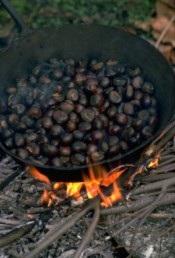
Chestnuts roasting over an open fire in a wire basket or in a special perforated chestnut roaster pan, on the range in a large skillet over medium heat for 15 minutes, or in the microwave.
Note: Vary the cooking times to suit for all of the methods listed above. If they cool off too much after they are cooked, they can become harder to peel. If this happens, just put them back into the oven, or boiling water, to reheat.
Curing
Usually, chestnuts are harvested fresh. Because of this, we recommend an important curing process be followed prior to cooking. Curing makes the nuts far easier to peel as it allows the nut to shrink away from the inner skin (the pellicle). It also ripens and sweetens the nut, as the starches in the nut are converted to sugar.
- Put the chestnuts in a bowl and leave at room temperature.
- On a daily or semi-daily basis, pinch the nut between your thumb and forefinger. If there is no give, the nut needs more curing time. If there is a slight give between the outer shell and the nut inside, the nut has begun the curing process. Note: a small dimple in the outer shell may be noticed. This is caused because the nut is shrinking away from the outer shell and pellicle.
- Once the chestnuts are properly cured i.e. the outer shell and pellicle are easily removed from the nut, they are ready for cooking.
Curing Tips
- Do not over cure the nut as it could dry out and become hard.
- Curing under sunlight can speed up the process. Again be careful not to over cure.
- The curing process can take between 2 to 7 days.
- Naturally, during shipment, the curing process has already begun.
Storage
Chestnuts should be stored with great care and attention. Unlike most other nuts, they are highly perishable. They are comprised of about 40-50 % water and thus, if not stored properly, can become prone to mold. Listed below are some tips for storing our product. The shelf life can be extended dramatically if stored properly.
- Recommend storing them in airtight containers in the coolest part of the refrigerator.
- Stored properly in the refrigerator, they can have a shelf life of approximately 4 weeks.
- It is best to store chestnuts in a constant environment of 30 degrees Fahrenheit.
- They also can be stored in the freezer for year-round enjoyment.
Peeling
- Chestnuts have an outer shell and an inner skin, which seals the nut.
- The outer shell is smooth, shiny, and durable.
- The inner skin (next to the meat) is more textured.
- Both outer shell and inner skin must be removed before eating.
- Both shell and skin are removed more easily after they have been cooked and are still warm.
Roasting Chestnuts
Preheat your oven to 425 degrees F.
Wipe the chestnuts off with a damp towel and set them on a cutting board, flat side down.
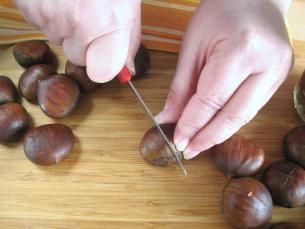
With a small, sharp knife cut an X in each chestnut. The X allows the steam to escape while they are cooking. (Do not omit this step, otherwise the chestunts could explode in the oven!) This will also make peeling a lot easier. For safety sake, you may feel more comfortable cushioning the chestnut on a (clean) dish towel to cut the X.
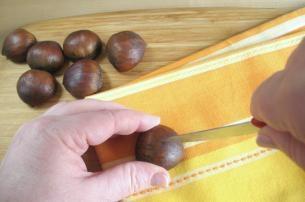
Put the chestnuts in a baking pan with the X facing up.
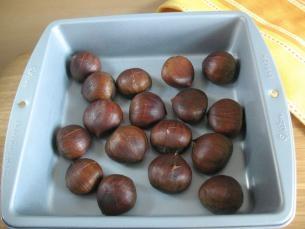
It will take 20-30 minutes to roast the chestnuts. When cooked, the shells will burst open, and the chestnut will be golden brown. The tricky part is actually knowing when they are done. If you over-cook OR under-cook them, they will get hard and the inner skin will be very difficult to remove.
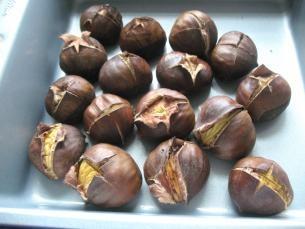
Now comes the hard part: peeling them! You need to peel them while they are still warm. Let them cool just enough so that you can touch them, then start peeling. Be very careful not to burn your fingers!
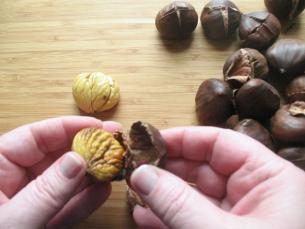
Be sure to buy extra, because once they are open you may discover that some have actually turned bad and are not edible.
|
|
|
|






